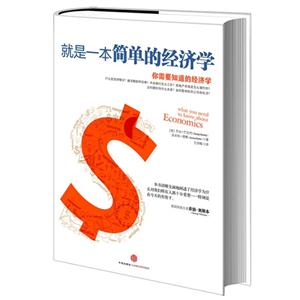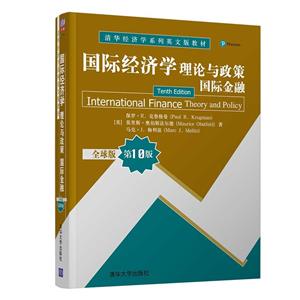
作者:保罗·基特(PaulG.Keat)等
页数:531页
出版社:中国人民大学出版社
出版日期:2017
ISBN:9787300241913
电子书格式:pdf/epub/txt
内容简介
本书是一本英文影印版教材,原著是一本内容丰富、案例鲜活、创新实用的管理经济学教材。 内容上,本书突出经济学理论对管理决策的重要作用,强调如何培养学生在实际管理情境中诊断问题、做出决策以及采取行动的能力。 体例上,每章都以一个引导案例开始,案例中一家公司的管理者正需要针对产品做出一个重要决策;然后介绍有关重要的经济学概念和分析工具;最后在每章结尾提供有关问题的解决方案,即建议一种方式,应用该章的概念和工具帮助管理者做出最好的决策。 本书非常适合用作本科生、研究生的管理经济学双语教学或全英语教学教材,也适合从事相关工作的业界人士学习参考。
作者简介
保罗•基特(Paul G. Keat) 美国雷鸟全球管理学院名誉副教授,在雷鸟担任全球商务教师长达近30年。此前,曾在IBM公司工作多年,拥有丰富的管理经验。他在纽约城市大学获得工商管理学士学位,在华盛顿大学获得文学硕士学位,在芝加哥大学获得经济学博士学位。曾在美国多所大学任教,包括华盛顿大学、纽约城市大学和爱纳大学,还在佩斯大学讲授EMBA课程。
菲利普•扬(Philip K. Y. Young) 曾任美国雷鸟全球管理学院管理学教授,现为美国Nth Degree Systems咨询公司的创始人兼总裁,该公司是一家为许多全球大公司提供定制教育和培训的咨询公司。拥有纽约大学经济学博士学位。
斯蒂芬•艾弗尔(Stephen E. Erfle) 美国Dickinson大学副教授,帮助创建了该校国际商务与管理系和专业,主讲管理经济学课程。拥有哈佛大学经济学博士学位。
本书特色
本书是一本英文影印版教材,原著是一本内容丰富、案例鲜活、创新实用的管理经济学教材。
内容上,本书突出经济学理论对管理决策的重要作用,强调如何培养学生在实际管理情境中诊断问题、做出决策以及采取行动的能力。
体例上,每章都以一个引导案例开始,案例中一家公司的管理者正需要针对产品做出一个重要决策;然后介绍有关重要的经济学概念和分析工具;最后在每章结尾提供有关问题的解决方案,即建议一种方式,应用该章的概念和工具帮助管理者做出最好的决策。
本书非常适合用作本科生、研究生的管理经济学双语教学或全英语教学教材,也适合从事相关工作的业界人士学习参考。
目录
ChAPtEr 1 Introduction 1
Introduction: Economics and Managerial Decision Making 2
A Brief Review of Important Economic Terms and Concepts 5
The Case of Global Foods, Inc.: Situations and Solutions 9
Summary of the Situations and Solutions 11
Global Application: The BRIC Countries 14
Summary 15
Important Concepts 16
Questions 16
ChAPtEr 2 the Firm and Its Goals 18
Introduction 19
Do Companies Really Try to Maximize Profits? 26
Maximizing the Wealth of Stockholders 29
Economic Profits 32
Global Application 34
Summary 35
Important Concepts 35
Questions 36
ChAPtEr 3 Supply and Demand 38
Introduction 39
Market Demand 39
Market Supply 42
Market Equilibrium 44
Comparative Statics Analysis 46
Supply, Demand, and Price: The Managerial Challenge 53
Global Application: The BRIC Countries and the Supply and Demand for Oil 53
Summary 56
Important Concepts 56
Questions 57
Problems 58
Appendix 3A The Mathematics of Supply and Demand 65
ChAPtEr 4 Demand Elasticity 68
The Economic Concept of Elasticity 69
The Price Elasticity of Demand 69
i
Contents
The Cross-Price Elasticity of Demand 86 Income Elasticity 87
Other Elasticity Measures 90 Elasticity of Supply 90
Global Application: Price Elasticities in Asia 91
Summary 93
Important Concepts 94
Questions 94
Problems 96
Appendix 4A Applications of Supply and Demand 100
ChAPtEr 5 Demand Estimation and Forecasting 114
Demand Estimation 115
Introduction 115
Introduction to Regression Analysis 117
Problems in the Use of Regression Analysis 125
Examples of Regression Analysis Across the Disciplines 129
Global Application: Food in Spain, Cigarettes in Chinese Taiwan 130
Forecasting 132
Introduction 132
Subjects of Forecasts 132
Prerequisites of a Good Forecast 133
Forecasting Techniques 133
Global Application: Forecasting Exchange Rates 156
Summary 159
Important Concepts 159
Questions 161
Problems 162
Appendix 5A The Demand for White Zinfandel in Los Angeles 167
ChAPtEr 6 the theory and Estimation of Production 175
The Production Function 176
A Short-Run Analysis of Total, Average, and Marginal Product 178
The Long-Run Production Function 188
The Estimation of Production Functions 191
The Importance of Production Functions in Managerial Decision Making 200
Going “Beyond the Curves”: Current Production Issues and Challenges for Today’s Managers 202
Call Centers: Applying the Production Function to a Service 204
Global Application: Shifting Trends in Global Outsourcing 205
Summary 206
Important Concepts 207
Questions 208
Problems 209
Appendix 6A Productivity in Services 215
Appendix 6B The Multiple-Input Case 226
Contents
ChAPtEr 7 the theory and Estimation of Cost 237
The Importance of Cost in Managerial Decisions 238
The Definition and Use of Cost in Economic Analysis 240
The Relationship Between Production and Cost 242
The Short-Run Cost Function 244
The Long-Run Cost Function 249
The Learning Curve 258
Economies of Scope 261
Economies of Scale: The Short Run Versus the Long Run 262
Supply Chain Management 262
Examples of Ways Companies Have Cut Costs to Remain Competitive 265
Cautionary Note to Managers About the Use of Cost-Cutting as a Strategy 268
Global Applications: Li & Fung Will Do It All for You 269
Summary 271
Important Concepts 271
Questions 272
Problems 274
Appendix 7A A Mathematical Restatement of the Short-Run Cost Function 280
Appendix 7B The Estimation of Cost 284
ChAPtEr 8 Pricing and Output Decisions: Perfect Competition and Monopoly 295
Introduction 296
Competition and Market Types in Economic Analysis 298
Pricing and Output Decisions in Perfect Competition 301
Pricing and Output Decisions in Monopoly Markets 314
The Implications of Perfect Competition and Monopoly for Managerial Decision Making 318
Global Application: The $736,000 Bluefin Tuna 320
Summary 323
Important Concepts 323
Questions 324
Problems 326
Appendix 8A The Use of Calculus in Pricing and Output Decisions 328
Appendix 8B Break-Even Analysis (Volume-Cost-Profit) 330
ChAPtEr 9 Pricing and Output Decisions: Monopolistic Competition and Oligopoly 346
Introduction 346
Monopolistic Competition 348
Oligopoly 350
Pricing in an Oligopolistic Market: Rivalry and Mutual Interdependence 352
Contents
Competing in Imperfectly Competitive Markets 354
Strategy: The Fundamental Challenge for Firms in Imperfect Competition 357
Global Application: The World’s Market for Beer 363
Summary 365
Important Concepts 365
Questions 366
Problems 367
Appendix 9A A Mathematical Restatement of Monopolistic Competition 372
ChAPtEr 10 Special Pricing Practices 375
Introduction 376
Cartel Arrangements 376
Price Leadership 381
Revenue Maximization 383
Price Discrimination 384
Nonmarginal Pricing 395
Multiproduct Pricing 400
Transfer Pricing 405
Other Pricing Practices 407
Global Application: The Decline of European Cartels 408
Summary 411
Important Concepts 412
Questions 412
Problems 413
ChAPtEr 11 Game theory and Asymmetric Information 417
Introduction 418
Game Theory: Modeling the Strategy of Conflict 419
Asymmetric Information 428
Summary 438
Important Concepts 440
Questions 441
Problems 442
ChAPtEr 12 Capital Budgeting and risk 446
Introduction 447
The Capital Budgeting Decision 448
Time Value of Money 449
Methods of Capital Project Evaluation 449
Cash Flows 455
Cost of Capital 457
The Capital Budgeting Model 460
Capital Rationing 462
Risk Versus Uncertainty 462
Sources of Business Risk 463
Contents
The Measures of Risk 463
Capital Budgeting Under Conditions of Risk 468 Two Other Methods for Incorporating Risk 469 Sensitivity and Scenario Analysis 471
Simulation 472
Decision Trees 473
Real Options in Capital Budgeting 475
Global Application 478
Summary 483
Important Concepts 483
Questions 484
Problems 485
Appendix 12A The Value of a Corporation 492
ChAPtEr 13 Government and Industry: Challenges and Opportunities for today’s Manager 494
Introduction 495
The Rationale for Government Involvement in a Market Economy 495
Stabilization of the Aggregate Economy: Monetary and Fiscal Policy 502
Subprime Loan Financial Crisis of 2007 to 2009 503
Government Deregulation, Mergers, and Acquisitions 507
Government Protection of Intellectual Property (IP) 512
Global Application: The Failed Attempt to Merge by General Electric and Honeywell 514
Summary 515
Important Concepts 515
Questions 516
Appendix A Statistical and Financial Tables 517















